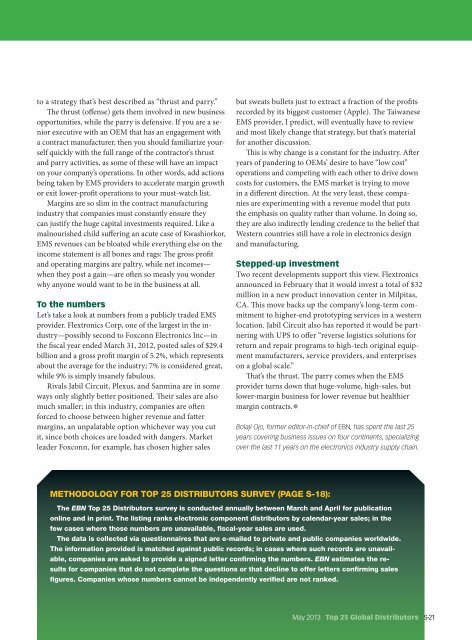201305.pdf 43279KB May 08 2013 11:07:04 PM
201305.pdf 43279KB May 08 2013 11:07:04 PM
201305.pdf 43279KB May 08 2013 11:07:04 PM
You also want an ePaper? Increase the reach of your titles
YUMPU automatically turns print PDFs into web optimized ePapers that Google loves.
to a strategy that’s best described as “thrust and parry.”The thrust (offense) gets them involved in new businessopportunities, while the parry is defensive. If you are a seniorexecutive with an OEM that has an engagement witha contract manufacturer, then you should familiarize yourselfquickly with the full range of the contractor’s thrustand parry activities, as some of these will have an impacton your company’s operations. In other words, add actionsbeing taken by EMS providers to accelerate margin growthor exit lower-profit operations to your must-watch list.Margins are so slim in the contract manufacturingindustry that companies must constantly ensure theycan justify the huge capital investments required. Like amalnourished child suffering an acute case of Kwashiorkor,EMS revenues can be bloated while everything else on theincome statement is all bones and rags: The gross profitand operating margins are paltry, while net incomes—when they post a gain—are often so measly you wonderwhy anyone would want to be in the business at all.To the numbersLet’s take a look at numbers from a publicly traded EMSprovider. Flextronics Corp, one of the largest in the industry—possiblysecond to Foxconn Electronics Inc—inthe fiscal year ended March 31, 2012, posted sales of $29.4billion and a gross profit margin of 5.2%, which representsabout the average for the industry; 7% is considered great,while 9% is simply insanely fabulous.Rivals Jabil Circuit, Plexus, and Sanmina are in someways only slightly better positioned. Their sales are alsomuch smaller; in this industry, companies are oftenforced to choose between higher revenue and fattermargins, an unpalatable option whichever way you cutit, since both choices are loaded with dangers. Marketleader Foxconn, for example, has chosen higher salesbut sweats bullets just to extract a fraction of the profitsrecorded by its biggest customer (Apple). The TaiwaneseEMS provider, I predict, will eventually have to reviewand most likely change that strategy, but that’s materialfor another discussion.This is why change is a constant for the industry. Afteryears of pandering to OEMs’ desire to have “low cost”operations and competing with each other to drive downcosts for customers, the EMS market is trying to movein a different direction. At the very least, these companiesare experimenting with a revenue model that putsthe emphasis on quality rather than volume. In doing so,they are also indirectly lending credence to the belief thatWestern countries still have a role in electronics designand manufacturing.Stepped-up investmentTwo recent developments support this view. Flextronicsannounced in February that it would invest a total of $32million in a new product innovation center in Milpitas,CA. This move backs up the company’s long-term commitmentto higher-end prototyping services in a westernlocation. Jabil Circuit also has reported it would be partneringwith UPS to offer “reverse logistics solutions forreturn and repair programs to high-tech original equipmentmanufacturers, service providers, and enterpriseson a global scale.”That’s the thrust. The parry comes when the EMSprovider turns down that huge-volume, high-sales, butlower-margin business for lower revenue but healthiermargin contracts.•Bolaji Ojo, former editor-in-chief of EBN, has spent the last 25years covering business issues on four continents, specializingover the last <strong>11</strong> years on the electronics industry supply chain.methodology for top 25 distributors survey (page s-18):the EBN top 25 distributors survey is conducted annually between march and april for publicationonline and in print. the listing ranks electronic component distributors by calendar-year sales; in thefew cases where those numbers are unavailable, fiscal-year sales are used.the data is collected via questionnaires that are e-mailed to private and public companies worldwide.the information provided is matched against public records; in cases where such records are unavailable,companies are asked to provide a signed letter confirming the numbers. EBN estimates the resultsfor companies that do not complete the questions or that decline to offer letters confirming salesfigures. Companies whose numbers cannot be independently verified are not ranked.<strong>May</strong> <strong>2013</strong> Top 25 Global Distributors S-21






![[270].pdf 37407KB Sep 02 2010 09:55:57 AM - ElectronicsAndBooks](https://img.yumpu.com/50350834/1/185x260/270pdf-37407kb-sep-02-2010-095557-am-electronicsandbooks.jpg?quality=85)
![draaien, A Viruly 1935 OCR c20130324 [320]. - ElectronicsAndBooks](https://img.yumpu.com/49957773/1/190x252/draaien-a-viruly-1935-ocr-c20130324-320-electronicsandbooks.jpg?quality=85)



![20051110 c20051031 [105].pdf 35001KB Feb 18 2009 08:46:32 PM](https://img.yumpu.com/48687202/1/190x253/20051110-c20051031-105pdf-35001kb-feb-18-2009-084632-pm.jpg?quality=85)




